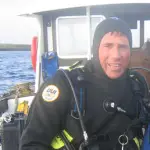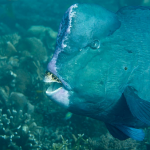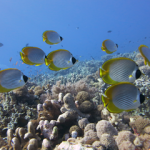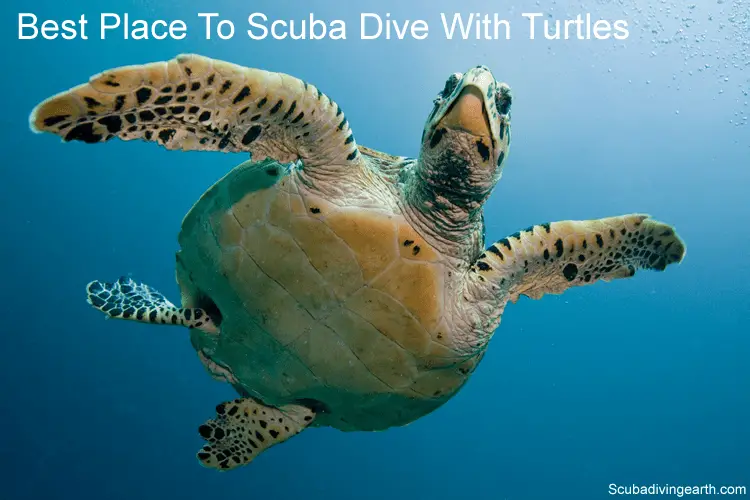
Where’s the best place in the world to scuba dive with turtles?
If you’re like me and love to see turtles when you scuba dive, then you’ll want to dive where you’re in the best place to see them.
The best place to scuba dive with turtles includes:
- The Red Sea in Egypt.
- The Great Barrier Reef.
- Bonaire.
- Barbados Caribbean sea.
- Akumal Caribbean sea.
- Exmouth and the Ningaloo Reef in Australia.
- Sipadan in Malaysia.
- Zakynthos or Zante, Greece.
- Hawaii, USA.
The best way to do more diving and to see more turtles is to book yourself on a scuba diving liveaboard. You can check the latest and best deals on liveaboards using the following window:
There are seven species of extant sea turtles, which are explained in detail below.

Best place to scuba dive with turtles
There are many places around the world where you’ll see turtles. I’ve probably seen most of my sea turtles in the Red Sea, Egypt. But other great places include most islands in the Caribbean, The Great Barrier Reef and the Ningaloo Reef in Australia, the Maldives, Hawaii, Sipadan off Malaysia. Plus many other places around the world.
Some of the best places that I’ve seen turtles include the following:
1. The Red Sea Egypt is one of the best places to scuba dive with turtles
Five of the seven extant species of marine turtle live in the Red Sea. In my opinion, the best way to see turtles in the Red Sea is to join a liveaboard boat trip.

Red Sea dive liveaboards table
This list of Red Sea liveaboards is in descending customer rating order, followed by Scuba Diving Luxury Rating (SDE Lux Rating, see below), so the liveaboards with the highest customer rating and the best SDE lux rating will be at the top of the list. If you want to change the list order, use the “Sort by” dropdown below.
| Discover Liveaboard | Customer Rating | SDE Lux Rating % | Flexible Booking | Dive Courses | Dietary Requirements | Nitrox | Gear Rental | |
|---|---|---|---|---|---|---|---|---|
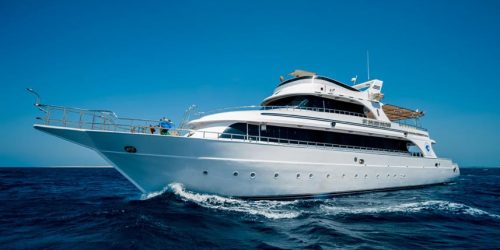 |
Review: MY Golden Dolphin; Book: MY Golden Dolphin | 9.5 | 77% | YES | YES | YES | YES | YES |
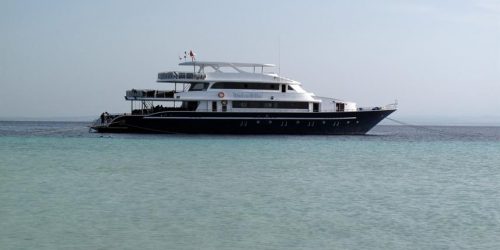 |
Review: MV Dolce Vita; Book: MV Dolce Vita | 9.5 | 69% | YES | YES | YES | YES | YES |
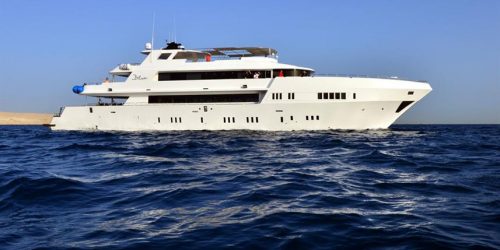 |
Review: MY Blue; Book: MY Blue | 9.5 | 63% | YES | YES | YES | YES | YES |
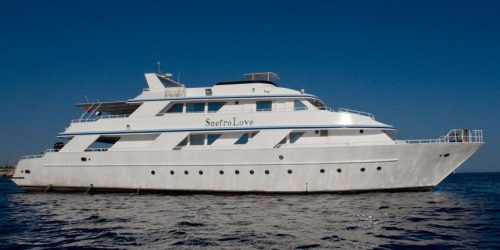 |
Review: MY Snefro Love; Book: MY Snefro Love | 9.4 | 67% | YES | YES | YES | YES | YES |
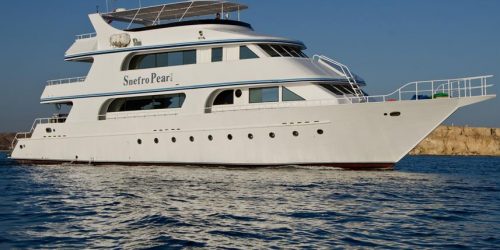 |
Review: MV Snefro Pearl; Book: MV Snefro Pearl | 9.4 | 67% | YES | YES | YES | YES | YES |
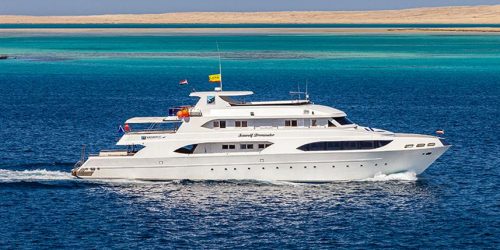 |
Review: MY Seawolf Dominator; Book: MY Seawolf Dominator | 9.4 | 62% | YES | YES | YES | YES | YES |
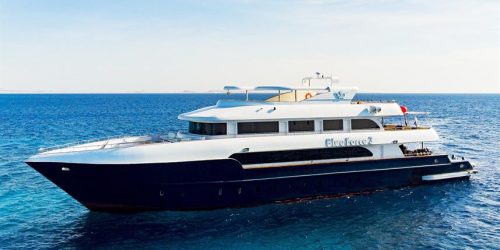 |
Review: MV Red Sea Blue Force 3; Book: MV Red Sea Blue Force 3 | 9.4 | 54% | YES | YES | YES | YES | YES |
The Scuba Diving Earth Luxury Rating (SDE Lux Rating) is explained on each liveaboard review when you click the “Discover Liveaboard” link, and is my own Liveaboard Luxury Rating I’ve assigned to all liveaboards. Choosing between liveaboards is helped by customer scores, and if you get stuck choosing between two or three liveaboards, where each one has a high customer score out of 10, you can use the SDE Luxury Rating to help narrow down your choice.
Think about it like using Booking.com when searching for the best hotel. Booking.com also use a customer score where each customer rates hotels out of 10. This is similar to the liveaboard customer rating, which is also rated out of 10. But let’s say you only like to stay in hotels rated 8 and above on Booking.com, but you also want the hotel to have WIFI or parking, or to have a swimming pool etc. The features each hotel has is usually secondary to the score out of 10.
Each time I’ve dived the Red Sea from a liveaboard, I’ve seen sea turtles on almost every dive site. That’s not to say you won’t see them when you shore dive from places like Hurghada and Sharm El Sheikh, because you will.
Probably one of the best times I experienced turtles was on a night dive on the Thistlegorm wreck. There’s a large plate under the main deck of the wreck where we came across two of the largest Leatherback Sea Turtles I’ve ever seen. They were laying there sleeping side by side.
We observed them and then swam away to leave them to continue their sleep. This became my best night dive ever.
The second time I had a lovely experience in the Red Sea with turtles was with a Hawksbill Sea Turtle. This experience was at around 5-6 metres (16-20 feet) at the end of a dive.
This turtle was feeding on jellyfish that were floating near the surface. I was holding some of the jellyfish and this wild Hawksbill was taking the jellyfish from my hand. It was an amazing experience to have a wild creature trust me and to take food from my hand in this way.
In addition to Leatherbacks and Hawksbill turtles, you will also find Green Turtles, Loggerhead Turtles and the Olive-Ridley Turtle in the Red Sea.

2. The Great Barrier Reef is one of the best places to scuba dive with turtles
The Great Barrier Reef is where you can see six of the seven sea turtles (see below for a list of all seven extant marine turtles).
Sea turtles seen on the Great Barrier Reef include:
- Green Turtles.
- Loggerhead Turtles.
- Leatherhead Turtles.
- Flatback Turtle.
- Olive Ridley Turtle.
- Hawksbill Turtle.
The best way to experience and to see turtles on the Great Barrier Reef is by liveaboard boat. On a liveaboard you get to do more dives per day and you are able to reach further out into the Great Barrier Reef ecosystem.
Great Barrier Reef dive liveaboards table
This list of Australia Great Barrier Reef liveaboards is in descending customer rating order, followed by Scuba Diving Luxury Rating (SDE Lux Rating, see above), so the liveaboards with the highest customer rating and the best SDE lux rating will be at the top of the list. If you want to change the list order, use the “Sort by” dropdown below.
| Discover Liveaboard | Customer Rating | SDE Lux Rating % | Flexible Booking | Dive Courses | Dietary Requirements | Nitrox | Gear Rental | |
|---|---|---|---|---|---|---|---|---|
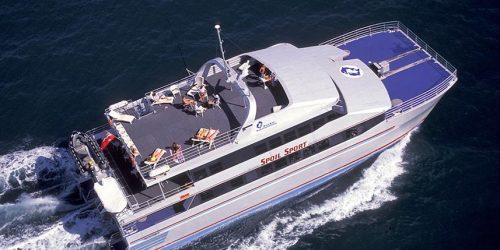 |
Review: MY Spoilsport; Book: MY Spoilsport | 9.4 | 73% | YES | YES | YES | YES | YES |
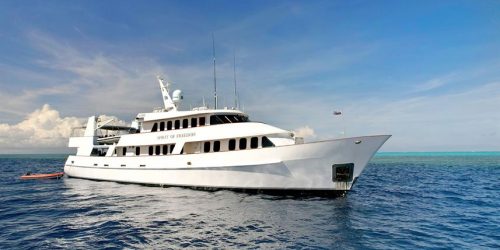 |
Review: MY Spirit of Freedom; Book: MY Spirit of Freedom | 9.3 | 83% | YES | YES | YES | YES | YES |
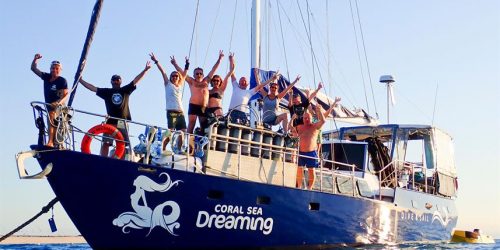 |
Review: Coral Sea Dreaming; Book: Coral Sea Dreaming | 9.2 | 62% | YES | YES | YES | NO | YES |
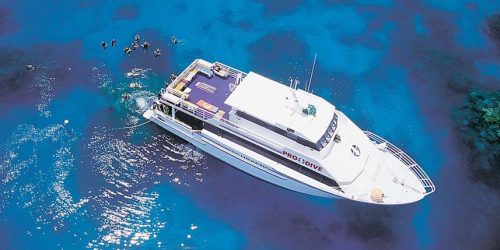 |
Review: MY Pro Dive Cairns; Book: MY Pro Dive Cairns | 9.2 | 52% | YES | YES | YES | YES | YES |
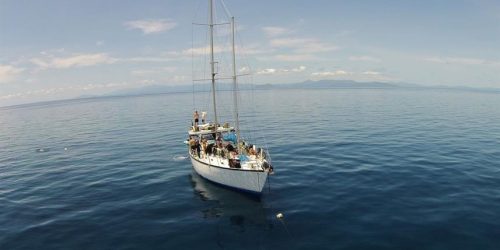 |
Review: Rum Runner; Book: Rum Runner | 9 | 44% | YES | YES | YES | NO | YES |
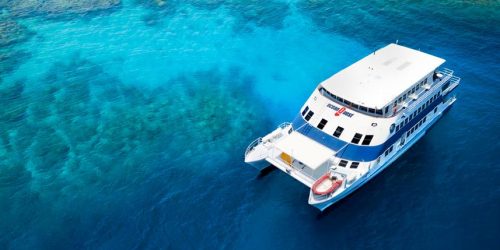 |
Review: MY Ocean Quest; Book: MY Ocean Quest | 9 | 40% | YES | YES | YES | YES | YES |
The Great Barrier Reef and it’s many islands are home to the breeding grounds for all of these six marine turtle species.
3. Bonaire Caribbean sea turtles
Sea turtles are extremely common in Bonaire. But an added bonus of scuba diving in Bonaire is that it has the best shore dives in the world. The diving is very cheap if you visit as a buddy pair.
Find out more by reading this article about the best shore dives of Bonaire.
I’ve seen many sea turtles on dives in the Caribbean, but not on every dive. Out of the seven extant species of sea turtle, there are five species that live in the Gulf Of Mexico.
Turtles of the Caribbean include:
- Loggerhead Turtles.
- Kemps Ridley Turtles.
- Green Turtles.
- Leatherback Turtles.
- Hawksbill Turtles.
One of the best places in the Caribbean to experience marine turtles is Bonaire. The reason why I say Bonaire is five-fold.
- Bonaire is out of the main hurricane belt of the Caribbean, which means it’s rarely affected by hurricanes.
- The diving is easy diving. Most dive sites you can choose your depth. This means that both beginner and advanced scuba divers can enjoy the diving in Bonaire.
- Bonaire is one of the cheapest places to scuba dive in the world when you shore dive there.
- There are plenty of marine turtles to be seen on many of the dive sites.
- You can also enjoy the same sites snorkeling too.
4. Barbados is the best place to see turtles in Caribbean
The other great place to experience turtles in the Caribbean is in Barbados. You can either find them when scuba diving, or it easy to see them snorkeling off the west coast near Hole Town. Hawksbill and leatherback turtles make Barbados their home and nest on the beaches.
5. Akumal, Mexico sea turtles
There’s a tiny beach in Mexico called Akumal, which is a Maya word that translates to “place of the turtles“. You can experience mostly Green Sea Turtles, but also Loggerhead Turtle too.
Akumal is about 100 kilometres (62 miles) south of Cancun, Mexico. It’s between Playa Del Carmen and Tulum and over looks Akumal Bay.
Akumal Bay was declared a marine refuge in March 2016. This is to protect the threatened turtle population.
The area is protected by a reef and the waters are shallow and go down to a depth of around 5 metres (16 feet).
The sea bed is very sandy where sea grass grows. Sea grass is what Green Turtles feed on. The nesting season for the Green Turtles starts in May, but you might get to see the last of the hatchings at the end of October. If you miss the nesting season, you will see turtles in the bays and lagoon year-round.
6. Exmouth west coast of Australia near the Ningaloo Reef turtles
It was on the beaches in Exmouth that I witnessed my first turtle laying. These beautiful creatures haul themselves up the beach leaving what looks like tank tracks up the sand.
They then carefully dig an almost perfectly round hole with their back flippers. It’s only then that they lay their eggs. The turtles carefully cover their eggs with sand and are left to hatch. The eggs take 45-55 days to hatch for Loggerheads and 70-80 days for Leatherbacks.
I also recall stopping on my way to Exmouth at a point to witness hundreds of turtles in the sea.
Looking out I witnessed hundreds of turtle heads popping up for air, before dipping down out of site once more.
I apologise for not remembering this exact spot, but if you want to enjoy one of the best trips of Australia, I suggest you hire a four-wheel-drive vehicle and drive the west coast of Australia from Perth to Exmouth. It’s a long drive, but well worth it.
7. Sipadan, Malaysia sea turtles
Sipadan is one of the top dive destinations in the world. In fact Sipadan is included on Jacques Cousteau’s list of top ten dive sites in the world.
Sipadan is one of the many protected turtle nesting sites around the world. Whether you snorkel or scuba dive you are very likely to see turtles.
Sipadan is the only oceanic island in Malaysia. The island rises up 600 metres (1968 feet) from the sea bed and is located in the Celebes Sea. The sea life there is simply amazing. Included in this marine life are plenty of sea turtles.
Of the seven extant marine turtles, you are likely to see Green and Hawksbill Sea Turtles there. On some dives you are likely to see between 20-30 turtles one one dive.
Video of a dive from Sipadan:
8. Zakynthos or Zante, Greece and the best place to see turtles in Europe
For those of you who live in the UK or Europe and don’t want to travel long-haul to see marine turtles, we have them on our door step in the Mediterranean. Zakynthos is a Greek Island and is known for an abundance of sea turtles.
In particular Loggerhead Sea Turtles are found around this small island in the Mediterranean Sea. There are boat trips with glass bottom boats for those that don’t like snorkeling or scuba diving. There’s a video below of a Loggerhead Sea Turtle in Zakynthos.
Every summer there are hundreds of Loggerhead Turtles that return to Zakynthos to mate and lay their eggs. They lay their eggs on the beaches in Laganas Bay.
Zakynthos or Zante is the most important turtle nesting ground in Europe. It’s estimated that around 80% of the Mediterranean population of Loggerheads return to Laganas Bay each summer.
9. Hawaii is the best place to dive or swim with sea turtles united states
The Hawaiian Islands are some of the most remote islands in the world. It is this remoteness that attracts turtles, which are known as “Honus” in Hawaii.
Something you may or may not like to know, but Hawaii is also home to tiger sharks too. Turtles are on the menu for tiger sharks, which is one reason why they make their home there.
The turtles you see in Hawaii include:
- Green turtle.
- Leatherback turtle.
- Loggerhead turtle.
- Olive Ridley sea turtle.
- Hawksbill.
The best place to snorkel with sea turtles is from the island of Maui. You are most likely to spot green turtles eating sea grass or algae. The green turtles of Hawaii can also be found resting on the beaches. This behaviour is only found on Hawaii along with Australia and the Galapagos Islands.
Turtles also use the Hawaiian islands for nesting sites too.
How to scuba dive with sea turtles
As with all wild sea creatures, respect is foremost important.
Never chase or harass sea turtles. Turtles can they bite you with their strong beaks, but this isn’t the best way to enjoy them either.
The best way to enjoy your experience when you spot a turtle is to either let it swim to you, or to approach it slowly. Depending on how much interaction a turtle has had with scuba divers, will depend on how shy it will be you.
Some carry on with their feeding and daily life despite scuba divers being around. The more you leave them to their own thing, the more likely they are to stay around you for longer.

Sea turtle species
There are seven species of extant sea turtle around the world, which are:
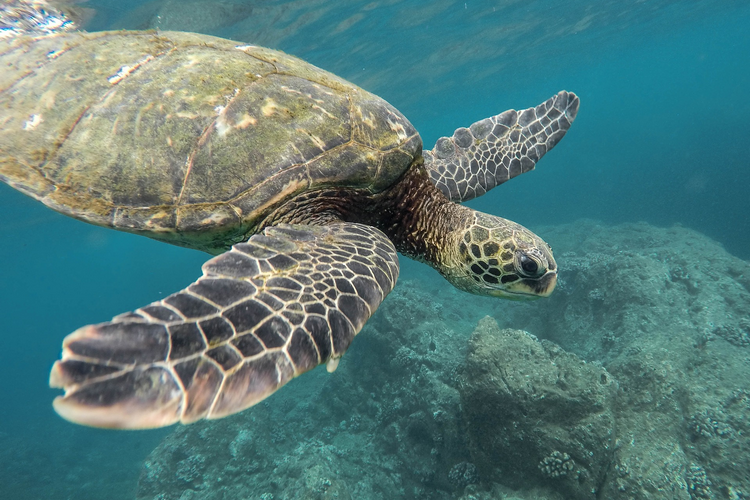
Green Sea Turtle
The Green Sea Turtle (Chelonia mydas) can be found in both tropical and subtropical seas. They are found in the Atlantic, Indian and Pacific Oceans.
Some confuse the name thinking its shell should be green. But that’s not the case. The Green Turtle gets its name from the green fat found underneath its carapace. Whereas its shell is olive to black in colour.
The Green Turtle is a herbivorous reptile living mostly on sea grasses in shallow lagoons.
Video of the Green Sea Turtle:
From the moment they are born, these plucky Green Turtles from the Ascension Islands will face a huge battle to survive. Those that do survive, like their mothers did before them, will return to exactly same beach where they hatched.
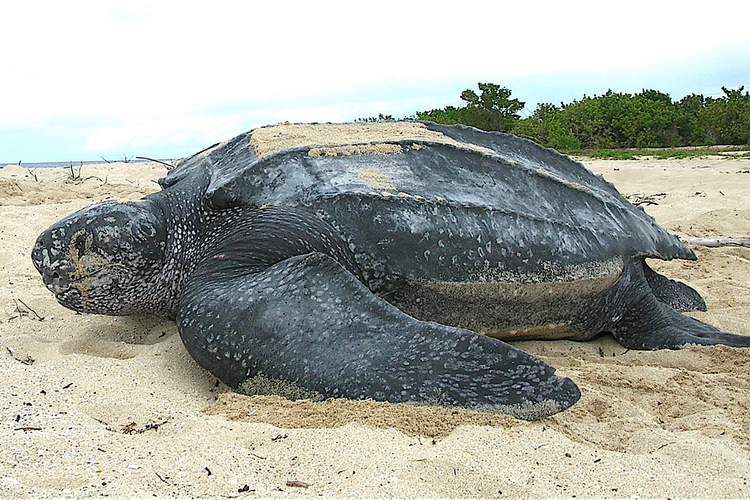
Leatherback Sea Turtle
The Leatherback Sea Turtle (Dermochelys coriacea), or sometimes called the lute or leathery turtle is the largest of all sea turtles. The Leatherback Turtle is also the fourth heaviest living reptile behind three types of crocodile. Leatherbacks can grow up to 2.7 metres (8.9 feet) in length.
It’s quite easy to distinguish the Leatherback Sea Turtle by its lack of bony shell. Which is how it got its name due to its more leather-like shell.
Due to their ability to maintain a high body temperature, Leatherback Turtles can be found as far north as Alaska and Norway and as far south as Cape Agulhas in Africa. They are also found around the southern most tip of New Zealand in the cold south ocean waters too.
Leatherback Turtles can be found in tropical, subtropical and arctic circle waters.
Leatherbacks are mostly found in open oceans and feed mainly on jellyfish. The Leatherback Sea Turtles are endangered, which is as a result of plastic bags in the oceans. They often mistake a plastic bag for a jellyfish, which then blocks their digestive track.
Video of the Leatherback Sea Turtle:
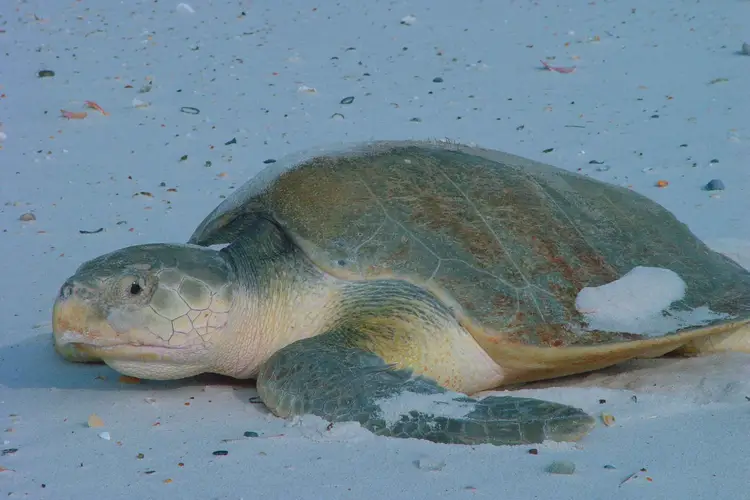
Kemp’s Ridley Sea Turtle
The Kemp’s Ridley Sea Turtle (Lepidochelys kempii) is the rarest of sea turtles. The smallest of all the sea turtles species, it’s also critically endangered. Adults reach only around 75cm (30 inches) in length.
It has an oval carapace or shell, which is olive-grey in colour. The Kemp’s Ridley Sea Turtle prefers warmer waters of the Atlantic and Gulf of Mexico, but can be found as far north as New Jersey.
They migrate to the warmer waters of the Gulf of Mexico and Florida, but almost all females return to a single beach Rancho Nuevo to lay their eggs. They nest between April and August each year.
The Kemp’s Ridley Sea Turtle’s diet consists mostly of crabs which they find in the shallow coastal waters.
Video of the Kemp’s Ridley Sea Turtle:
The Kemp’s Ridley Sea Turtle is making a comeback from the brink of extinction. Get a close-up look at turtle nesting and watch as the hatchlings crawl into the surf. For more information, visit the Padre Island National Seashore website http://www.nps.gov/pais/index.htm
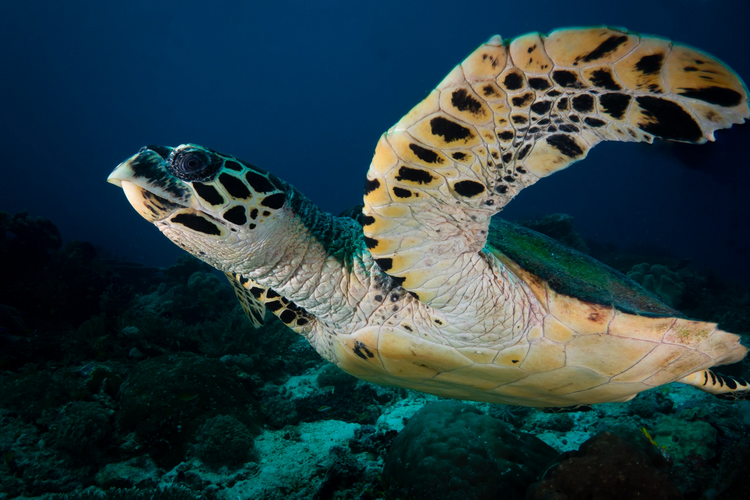
Hawksbill Sea Turtle
The Hawksbill Sea Turtle (Eretmochelys imbricata) is another of the critically endanger sea turtle species. The Hawksbill Sea Turtle is easily recognisable by its sharp curving beak, but also by the saw-like appearance of the outer edges of its shell.
Hawksbill Sea Turtles can be found in the Atlantic and Indo-Pacific regions. They mostly live in and around the tropical reefs of the Indian Ocean and Atlantic Oceans, preferring only warmer seas. In the Atlantic, Hawksbill Sea Turtles can be found as far west as the Gulf of Mexico and as far east as the Cape of Good Hope in South Africa.
In the Caribbean, Barbados is a good place to see Hawksbill Sea Turtle, as they tend to nest on the island of Barbados. But they can also be found in Guadeloupe, Costa Rica, Cuba and Puerto Rico amongst other places in the Caribbean.
In the Indo-Pacific region, they are found on the East coast of Africa, the Red Sea, the Persian Gulf, the Malay Archipelago and northern Australia and the Great Barrier Reef.
The main diet of Hawksbill Sea Turtles includes sea sponges, but they will also feed on jellyfish, anemones and algae too.
Video of the Hawksbill Sea Turtle on the Great Barrier Reef:
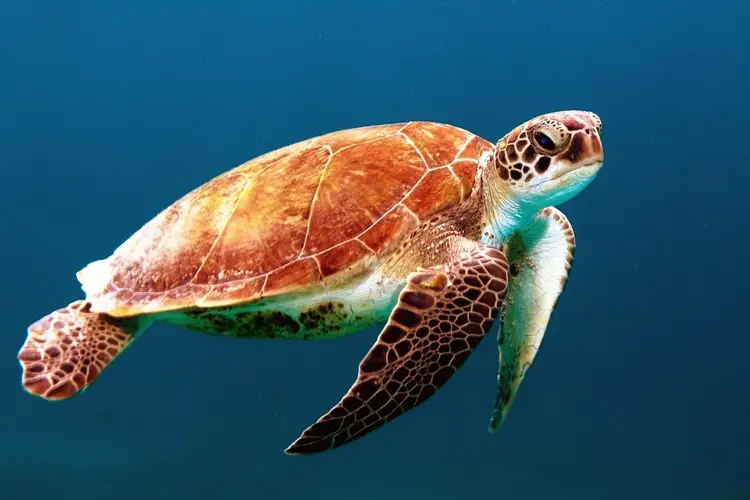
Loggerhead Sea Turtle
The Loggerhead Sea Turtles (Caretta caretta) can be found in the Atlantic Ocean, the Pacific Ocean, the Indian Ocean and also in the Mediterranean Sea. They are the largest of all the hard-shelled sea turtles and are second largest to the Leatherback Sea Turtles.
Loggerhead Sea Turtles are an omnivorous reptile. They mainly eat bottom-dwelling invertebrates such as gastropods, bivalves and decapods. They also eat sponges, corals sea worms, sea anemones, sea urchins, starfish and sea cucumbers.
Video of the Loggerhead Sea Turtle in Zakynthos or Zante
Intensive in-water surveys in Laganas bay, Zakynthos, Greece, revealed the existence of two aggregation hotspots for loggerhead sea turtles. The first one, a cleaning station, was occupied primarily by female turtles during their interesting period. The second, a small reef in the shallows, served as a foraging area. The solitary and the social behaviour of the turtles between these two spots was very different. At the cleaning station, female turtles did not involve in any fights, generally tolerating the presence of one another while being cleaned by fish and performing self-cleaning activities. In the foraging spot, on the other hand, which was used mainly by resident males, aggressive fights took place quite often as soon as one turtle was at the vicinity of the other.
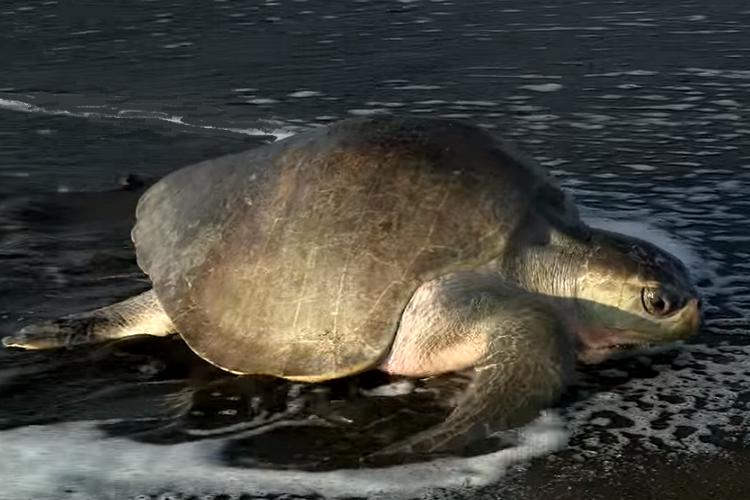
Olive Ridley Sea Turtle
The Olive Ridley Sea Turtle (Lepidochelys olivacea) is also known as the Pacific Ridley Sea Turtle. It’s also the most abundant of all sea turtles around the world.
They are mostly found in the tropical and warm waters of the Pacific and Indian Oceans, but also in the warmer waters of the Atlantic Ocean.
Their carapace is olive in colour and they grow to around two feet in length (0.6 metre). They are known for their mass nesting, and it’s on the coast of Odisha in India where there’s the largest mass nesting site for the Olive Ridley Sea Turtle. This is closely, followed by the coasts of Mexico and Costa Rica.
The Olive Ridley Sea Turtle is mostly carnivorous living on snails, jellyfish, sea urchins, shrimp, crabs, rock lobsters and worms.
Video of the Olive Ridley Sea Turtle:
Hundreds of thousands of olive ridley sea turtles all arrive together to lay their eggs near Ostional, Costa Rica—and we know little about how they coordinate that feat. Vanessa Bezy, a National Geographic young explorer grantee, is trying to find out more. To test the hypothesis that pheromones trigger the nesting behavior, she’s giving a number of turtles that are swimming toward the nesting site a zinc sulfate solution that will temporarily block their sense of smell, which will let her see whether they’re less likely to come ashore. The solution, which wears off within five days, doesn’t harm the turtles. The study, approved by the Costa Rican government and the University of North Carolina’s biology department, should provide invaluable information to conservation groups hoping to protect these animals.
Flatback Sea Turtle
The Flatback Sea Turtle (Natator depressus) can be found in the shallow coastal waters of Australia. They have an olive green to grey shell, with a cream underside.
The Flatback Sea Turtle is an omnivorous species, but predominately eats a carnivorous diet, feeding mostly on creatures they find in shallow coastal waters. Their diet includes soft corals, sea cucumbers, shrimp and jellyfish.
Video of the Flatback Sea Turtle:
I hope you enjoyed this article about the best place to scuba dive with turtles
I’d love to hear from you. Tell us about your adventures of diving and snorkeling, in the comments below. Please also share your photos. Either from your underwater cameras or videos from your waterproof Gopro’s!
If this article hasn’t answered all of your questions. If you have more questions either about snorkeling or scuba diving (or specifically about the best place to scuba dive with turtles), please comment below with your questions.
There will also be many more articles about scuba diving (and snorkeling) for you to read and learn about these fabulous sports.
Have fun and be safe!

